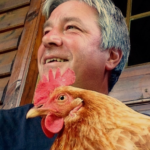
In this article, we will explore the chicken digestive system step by step, focusing specifically on the intestines.
Chickens might seem simple, but their digestive process is super intricate. Food travels from the beak, where it’s pecked and swallowed, down the esophagus to the crop, a storage pouch where food softens for digestion.
From the crop, food moves into the proventriculus, basically their version of a stomach, where digestive enzymes are released to break it down further.
Then, it moves to the gizzard, where digestion continues. The gizzard muscles use small stones or grit to grind hard foods so that the intestines can extract more nutrients.
The intestine is the real star of the show. It is the ultimate multitasker in a chicken’s body. Its primary jobs are nutrient absorption and waste elimination.
When food leaves the gizzard, it heads to the small intestine, where the magic happens. The walls of the small intestine absorb proteins, fats, and sugars. The absorbed nutrients then enter the bloodstream, feeding the chicken’s cells and providing energy for growth, egg production, and overall health.
Each section of the intestine has a specialized function. Most nutrient absorption occurs in the small intestine, which consists of the duodenum, jejunum, and ileum. The duodenum does the heavy lifting, releasing enzymes and bile that break down the food.
Moving along, the jejunum and ileum handle the bulk of nutrient absorption. Then, whatever is leftover, like indigestible fibers and excess water, passes into the large intestine.
Finally, the large intestine, which includes the ceca (two pouches unique to birds), reclaims water and absorbs any remaining nutrients. The ceca also help ferment any indigestible matter. By the time waste reaches the end of the line, most usable nutrients have been absorbed, and it’s ready to be expelled from the body.
Key Nutrients Absorbed in the Chicken Intestine
The small intestine is where chickens get the bulk of their nutrients. First, the duodenum. This part mixes bile and digestive enzymes with the food, breaking it into absorbable bits. This mix includes essential proteins, which are key for muscle and tissue development, and fats, which provide energy.
Next up, the jejunum and ileum come into play. Here, sugars and amino acids are absorbed. These are vital for energy and growth. A chicken’s diet needs to be balanced to ensure that these parts of the intestine can efficiently do their job. Lack of proper nutrition can hamper this process, leading to poor growth and health issues.
Remember the large intestine. Though its primary role is water absorption, it still grabs some essential minerals and vitamins on its way. It ensures that chickens stay hydrated and mineral-balanced, which is crucial for their overall well-being.
All the nutrient absorption happening in these areas directly impacts a chicken’s health.
Strong, healthy chickens are more productive, laying more eggs and having better meat quality. So, the focus should be on providing a balanced diet rich in proteins, fats, and essential vitamins. This will keep both the small and large intestines functioning smoothly and efficiently.
Promoting Optimal Gut Health in Chickens
Maintaining gut health in chickens is crucial for their overall well-being and productivity. Various factors come into play here, starting with their diet. A nutrient-rich, balanced diet filled with the right proteins, fats, and minerals is a must. Think of it as the foundational support for their entire digestive system.
Adding nutritional supplements can make a significant difference. Probiotics and prebiotics, for example, are game changers.
Probiotics introduce beneficial bacteria to the gut, promoting a healthy microbiome. The healthier the microbiome, the better the nutrient absorption and overall gut health.
Prebiotics, on the other hand, are like food for the good bacteria already present in the gut. Ensuring these are a part of their regular diet can improve their digestive health immensely.
Additionally, consider the physical aspects of their environment. Clean and spacious living conditions reduce the risk of diseases affecting gut health.
It’s also important to know how to spot and address common gut health issues. Symptoms like diarrhea, poor weight gain, or a drop in egg production could indicate digestive problems.
Early detection and treatment help prevent more serious health issues down the line. Always consult with a vet if you suspect any digestive issues in your flock.
Anatomy and Length of Chicken Intestines
The structure of the chicken intestines is quite fascinating and plays a crucial role in their digestion and nutrient absorption efficiency.
Generally, chicken intestines are divided into two main parts: the small intestine and the large intestine. The small intestine can be further broken down into the duodenum, jejunum, and ileum, while the large intestine includes the ceca and the rectum.
But what about the length? Well, a chicken’s intestine is surprisingly long. In fact, it can measure about four to five feet in length, which is quite impressive considering a chicken’s overall size.
This extensive length is essential for maximizing the surface area available for nutrient absorption, ensuring that chickens get the most out of their feed.
Comparing chicken intestines to other poultry and livestock reveals some interesting insights. Chickens typically have longer intestines relative to their body size than some other birds, which aids their high-efficiency digestion. This allows them to rapidly and effectively convert feed into energy, growth, and egg production.
The length and structure of the intestines also have physiological implications for chickens. Longer intestines mean that food has more time to be broken down and absorbed as it passes through the digestive tract.
This extended digestion process is particularly beneficial when chickens consume fibrous or harder-to-digest materials.
To keep the intestines functioning optimally, focus on providing a balanced diet and maintaining gut health through proper nutrition and a healthy living environment. A well-maintained digestive system is at the heart of a healthy, productive flock.
Dave

Chickenmethod.com
